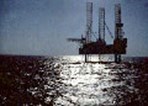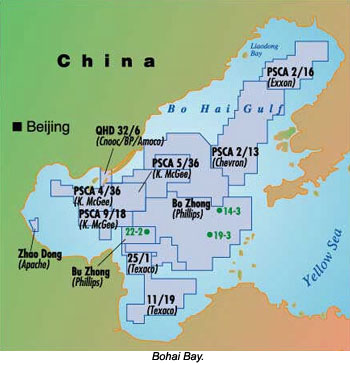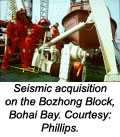Recently confirmed discoveries double China's offshore oil reserves

By Phil Dickson, Singapore
Contents
South China Sea
Bohai Bay
Elsewhere
 In our March review of E&P activity in the Chinese South China Sea, we pointed out that significant discoveries of oil and gas had been made and put in production during the past 20 years, without yielding a "giant" field. We stressed, as well, that SantaFe Snyder (before its merger with Devon), had just made two oil discoveries deserving appraisal in the South China Sea, and that the interest of foreign companies was shifting towards Bohai Bay in northeast China with discoveries by Phillips and Kerr McGee. These trends have since been reinforced with confirmation of commercial finds from both areas and reserves in excess of a billion bbl to be booked in the near future.
In our March review of E&P activity in the Chinese South China Sea, we pointed out that significant discoveries of oil and gas had been made and put in production during the past 20 years, without yielding a "giant" field. We stressed, as well, that SantaFe Snyder (before its merger with Devon), had just made two oil discoveries deserving appraisal in the South China Sea, and that the interest of foreign companies was shifting towards Bohai Bay in northeast China with discoveries by Phillips and Kerr McGee. These trends have since been reinforced with confirmation of commercial finds from both areas and reserves in excess of a billion bbl to be booked in the near future.
South China Sea(Return to Contents)
Devon (SantaFeSnyder) – The Panyu 4-2 and Panyu 5-1 discoveries in PSCA 15/34 mentioned in the previous review have been confirmed and renamed respectively the Ursa (4-2) and Bootes (5-1) Fields. The reserves are reported to be about 30 to 50 million bbl for the former and 50 to 70 million bbl for the latter, with an aggregate of up to120 million bbl. Reserves are located in multilayered sands with good permeability and 28API gravity oil. The fields, some 18 km apart, will have one multi-slot wellhead platform each, tied up to the same production facilities, with a plateau of 40-60,000 b/d and a FPSO with storage capacity of 800,000 bbl. Production is expected to begin in the fourth quarter of 2002. Baker Hughes with 50% interest in the PSCA is operator. SantaFeSnyder had built-up an acreage portfolio in the PRMB (Pearl River Mouth Basin) with interests in PSCA 15/26, 15/35, 16/02, 16/05, and 26/35 and carries on exploration with well Andromeda-1 on 15/35, 16 km to the northeast of Panyu.
Others - Elsewhere in the PRMB, China National Offshore Oil Corporation (CNOOC) proceeds with its plans to develop the 150 million bbl Wenchan 13-1 and 13-2 Fields. Burlington has been awarded PSCA 16/21, and Shell, a producer through Pecten, PSCA 15/12.
BP, which had withdrawn from upstream activity in China, now has a major Chinese portfolio ranging from oil (Liuhua 11-1 Field) and gas (Yacheng 13-1 Field) production to early stages of a geophysical survey (GSA Block 62/01), after its mergers with Amoco and Arco.
Bohai Bay (Return to Contents)
Bohai Bay, an offshore extension of China's most prolific oil province, has been under exploration by CNOOC since the 1960s and in cooperation with foreign companies since 1980, with a number of modest to medium-size fields put in production.

Several "rounds" of acreage awards have taken place, but recently, a major discovery and another commercial one have been made.
Phillips (PSCA Bozhong 11/05) – Among foreign companies, was an early player in the PRMB since 1983, with production from the Xijiang complex of fields since 1994 (currently 75,000 b/d). In Bohai Bay, however, Phillips signed the PSCA 11/05 in 1994 and made three marginal discoveries, Penglai 14-3, Bozhong 36-2, and Bozhong 22-2. A fourth discovery, Penglai 19-3-1, was drilled in 1999. Net pay is more than 200 meters over several intervals. The oil is waxy with gravity of 17-28 API. Reservoir characteristics are reported excellent with porosity greater than 30% and permeabilty in the range of 5-6 darcies. Four more appraisal wells have now been drilled on this structure.
As known onshore, the field is heavily faulted and compartmented. Various but growing estimates have been mentioned with OOIP as high as 4.4 billion bbl with recoverable reserves exceeding 800 million bbl, 500 million from a crestal zone and 300 from the flanks of the structure. These are still early days in view of the complexity of the field. It is, however, the most significant find in Bohai Bay to date. Development will be phased, with the possibility of early production of 35,000 b/d in the last quarter of 2001.
Two other discoveries, Penglai 9-1 and Penglai 25-6, have been made in 2000 and are to be appraised.
Kerr McGee (PSCA 04/36 and 05/36) – already a producer in the PRMB with a 24.5% interest in the Liuhua 11-1 field operated by BP, has been active in Bohai Bay since 1994, when it was awarded PSCA 04/36. A discovery well, Caofedian 2-1-1, was drilled in 1996. Three appraisal wells proved reserves in the range of 25 million bbl.
In December 1999, Kerr McGee drilled Caofedian 11-1-1, 50 km southeast of CFD 2-1-1 and proved 85 meters of net pay in several intervals. Four zones tested an aggregate 2,483 b/d of 17-20 API oil. With a reported closed area of more than 25 sq km, the field could hold reserves of in excess of 100 million bbl. The discovery has yet to be appraised.
Kerr McGee then signed the adjacent PSCA 05/36 and drilled the discovery well Caofedian 12-1-1, 16 km east of CFD 11-1-1. Two intervals were tested at a combined rate of 2,652 b/d . In August 2000, the results of Caofedian 12-1-2 appraisal well, 2.7 km north of Caofedian 12-1-1, were released with a flow of 2,700 b/d of 26-34 API oil, rather light by Bohai Bay standards. Discoveries are in shallow formations at depth between 750 and 1500 meters. Reserve estimates for CFD 12-1 have not been published yet. The partners have announced plans for a 3D seismic survey and an appraisal well on PSCA 04/36.
In September 2000, Kerr McGee was awarded another PSCA, 09/18 south of 04/36 and 05/36.
Kerr Mc Gee has not been successful in all its attempts in Bohai Bay and no significant result has been reported from the "beaches" blocks of Laopu and Getuo immediately north of PSCA 04/36.

Texaco (PSCA 11/19) - Another participant in Bohai Bay exploration since the late 80s and a producer in the South China Sea in the CACT association, it announced in July 1999, a discovery at Bozhong 25-1-8 with 35 meters of net pay.
BP (Qinhuangdao 32-6) is now involved in the development of the QHD 32-6 oilfield, with partners CNOOC (operator) and Texaco, as a result of its merger with Arco. The development is reported to be on track for start-up of production by the end of 2001, with peak production of 70,000 b/d for 200 million bbl reserves. In addition, Apache is expecting approval of the development plan for its Zhao Dong discovery.
Elsewhere(Return to Contents)
North of Bohai Bay, in Liaodong Bay, neither Chevron nor Exxon, operators, have reported any significant results from their two PSCAs, 02/31 and 02/16.
In the East China Sea, Primeline has reported results of well Lishui 36-2-1, an appraisal of its 1997 Vicky discovery on PSCA 32/32. It has flowed 12.3 million cf/d of gas and 190 b/d of condensate from several sand intervals. Vicky was the second discovery of some significance in the East China Sea after the Pinghu gas field developed by the Chinese for supply to Shangai. Further work will be needed to assess reserves estimated in the order of 700 billion cf and perhaps more with upside potential to be investigated.
 Oil discoveries made during the past three years in the PRMB and in the Bohai Bay have proven more than a billion bbl reserves—at least120 million from the PRMB Ursa and Bootes (PSCA 15/34), 800 million from Penglai 19-3 (PSCA Bozhong 11/05), and more than 120 million from CFD 2-1, 11-1 and 12-1 (PSCA 04/36 and 05/36)—spectacular results obtained by companies with a long history of E&P in China such as Phillips and to a lesser extent, Kerr McGee, and the more recent entrants such as Devon (SantaFeSnyder).
Oil discoveries made during the past three years in the PRMB and in the Bohai Bay have proven more than a billion bbl reserves—at least120 million from the PRMB Ursa and Bootes (PSCA 15/34), 800 million from Penglai 19-3 (PSCA Bozhong 11/05), and more than 120 million from CFD 2-1, 11-1 and 12-1 (PSCA 04/36 and 05/36)—spectacular results obtained by companies with a long history of E&P in China such as Phillips and to a lesser extent, Kerr McGee, and the more recent entrants such as Devon (SantaFeSnyder).
The majors heavily involved in the 80s such as Exxon and Shell are absent from recent discoveries, BP having reentered through its merger deals. Shell is still present in selected areas offshore and onshore. AGIP has recently signed a PSCA for the Sebei Block in the Qaidam Basin in central Western China with proven gas reserves of some 5 tcf in six gas fields.
It seems however that the majors have opted to invest directly, becoming minority shareholders in the partial privatization of the large national oil and gas companies, Petrochina (CNPC) for BP recently, with Sinopec and CNOOC soon to come, and interest expressed by BP, ExxonMobil, and Shell.
This is certainly a way to gain an insider's view of the operations of these integrated companies. Whether the foreign shareholder companies will have privileged access to upstream data and opportunities, remains to be seen.
With the ever-growing demand in energy in China and with giant projects such as the west-east gas pipeline and LNG imports, the will to increase domestic reserves and production of oil and gas is part of the global plan, and the goal of doubling offshore production from the current 400,000 b/d to 800,000 b/d in 2005 seems to be within reach.
